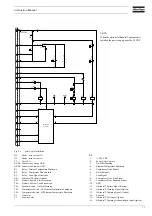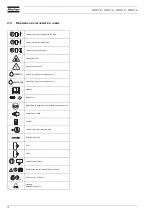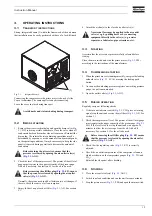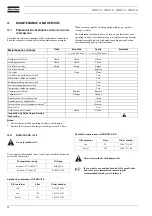
6
ORV 10 - ORV 12 - ORX 10 - ORX 12
1.3
S
AFETY
DURING
TRANSPORT
AND
INSTALLATION
To lift a unit, all loose or pivoting parts, e.g. doors, shall first be securely
fastened.
Use a fork lift truck with forks equal to or longer than the unit.
Helicopter lifting is not allowed.
It is strictly forbidden to dwell or stay in the risk zone under a lifted load.
Never lift the unit over people or residential areas. Lifting acceleration and
retardation shall be kept within safe limits.
1
To lift heavy parts, a hoist of ample capacity, tested and approved
according to local safety regulations, shall be used.
2
Lifting hooks, eyes, shackles, etc., shall never be bent and shall only
have stress in line with their design load axis. The capacity of a lifting
device diminishes when the lifting force is applied at an angle to its load
axis.
3
For maximum safety and efficiency of the lifting apparatus all lifting
members shall be applied as near to perpendicular as possible. If
required, a lifting beam shall be applied between hoist and load.
4
Never leave a load hanging on a hoist.
5
A hoist has to be installed in such a way that the object will be lifted
perpendicular. If that is not possible, the necessary precautions must be
taken to prevent load-swinging, e.g. by using two hoists, each at
approximately the same angle not exceeding 30° from the vertical.
6
Locate the unit away from walls. Take all precautions to ensure that hot
air exhausted from an engine and driven machine cooling systems cannot
be recirculated. If such hot air is taken in, this may cause overheating of
the unit.
7
Before moving the compressor, switch it off.
1.4
S
AFETY
DURING
USE
AND
OPERATION
1
When operating in a dust-laden atmosphere, place the unit so that dust is
not carried towards it by the wind. Operation in clean surroundings
considerably extends the intervals for cleaning the air intake filters and
the cores of the coolers.
2
Close the compressor air outlet valve before connecting or disconnecting
a hose. Ascertain that a hose is fully depressurized before disconnecting
it. Before blowing compressed air through a hose or air line, ensure that
the open end is held securely, so that it cannot whip and cause injury.
3
The air line end connected to the outlet valve must be safeguarded with a
safety cable, attached next to the valve.
4
No external force may be exerted on the air outlet valves, e.g. by pulling
on hoses or by installing auxiliary equipment directly to a valve, e.g. a
water separator, a lubricator, etc. Do not step on the air outlet valves.
5
Never move a unit when external lines or hoses are connected to the
outlet valves, to avoid damage to valves, manifold and hoses.
6
Do not use compressed air from any type of compressor, without taking
extra measures, for breathing purposes as this may result in injury or
death. For breathing air quality, the compressed air must be adequately
purified according to local legislation and standards. Breathing air must
always be supplied at stable, suitable pressure.
7
Distribution pipework and air hoses must be of correct diameter and
suitable for the working pressure. Never use frayed, damaged or
deteriorated hoses. Replace hoses and flexibles before the lifetime
expires. Use only the correct type and size of hose end fittings and
connections.
8
If the compressor is to be used for sand-blasting or will be connected to
a common compressed-air system, fit an appropriate non-return valve
(check valve) between compressor outlet and the connected sand-
blasting or compressed-air system. Observe the right mounting position/
direction.
9
Before removing the oil filler plug, ensure that the pressure is released by
opening an air outlet valve.
10 Never spill nor leave oil or cleansing agent in or around the unit.
11 All doors shall be shut during operation so as not to disturb the cooling
air flow inside the bodywork and/or render the silencing less effective. A
door should be kept open for a short period only e.g. for inspection or
adjustment.
12 Periodically carry out maintenance works according to the maintenance
schedule.
13 Stationary housing guards are provided on all rotating or reciprocating
parts not otherwise protected and which may be hazardous to personnel.
Machinery shall never be put into operation, when such guards have been
removed, before the guards are securely reinstalled.
14 Noise, even at reasonable levels, can cause irritation and disturbance
which, over a long period of time, may cause severe injuries to the
nervous system of human beings. When the sound pressure level, at any
point where personnel normally has to attend, is:
below 70 dB(A):
no action needs to be taken,
above 70 dB(A):
noise-protective devices should be provided for
people continuously being present in the room,
below 85 dB(A):
no action needs to be taken for occasional visitors
staying a limited time only,
above 85 dB(A):
room to be classified as a noise-hazardous area and
an obvious warning shall be placed permanently at
each entrance to alert people entering the room, for
even relatively short times, about the need to wear
ear protectors,
above 95 dB(A):
the warning(s) at the entrance(s) shall be completed
with the recommendation that also occasional
visitors shall wear ear protectors,
above 105 dB(A): special ear protectors that are adequate for this noise
level and the spectral composition of the noise shall
be provided and a special warning to that effect shall
be placed at each entrance.
15 The unit has parts, which may be accidentally touched by personnel, of
which the temperature can be in exess of 80 °C (176 °F). The insulation
or safety guard, protecting these parts shall not be removed before the
parts have cooled down to room temperature.
16 Never operate the unit in surroundings where there is a possibility of
taking in flammable or toxic fumes.
17 If the working process produces fumes, dust or vibration hazards, etc.,
take the necessary steps to eliminate the risk of personnel injury.
18 When using compressed air or inert gas to clean down equipment, do so
with caution and use the appropriate protection, at least safety glasses,
for the operator as well as for any bystander. Do not apply compressed
air or inert gas to your skin or direct an air or gas stream at people. Never
use it to clean dirt from your clothes.
19 When washing parts in or with a cleaning solvent, provide the required
ventilation and use appropriate protection such as a breathing filter,
safety glasses, rubber apron and gloves, etc.
20 Safety shoes should be compulsory in any workshop and if there is a risk,
however small, of falling objects, wearing of a safety helmet should be
included.
21 If there is a risk of inhaling hazardous gases, fumes or dust, the
respiratory organs must be protected and depending on the nature of the
hazard, so must the eyes and skin.
22 Remember that where there is visible dust, the finer, invisible particles
will almost certainly be present too; but the fact that no dust can be seen
is not a reliable indication that dangerous, invisible dust is not present in
the air.
23 Never operate the unit at pressures or speeds below or in excess of its
limits as indicated in the technical specifications.
Summary of Contents for ORV 10
Page 1: ...ORV 10 ORV 12 ORX 10 ORX 12 Instruction Manual for Portable Compressors English ...
Page 2: ......
Page 43: ......























